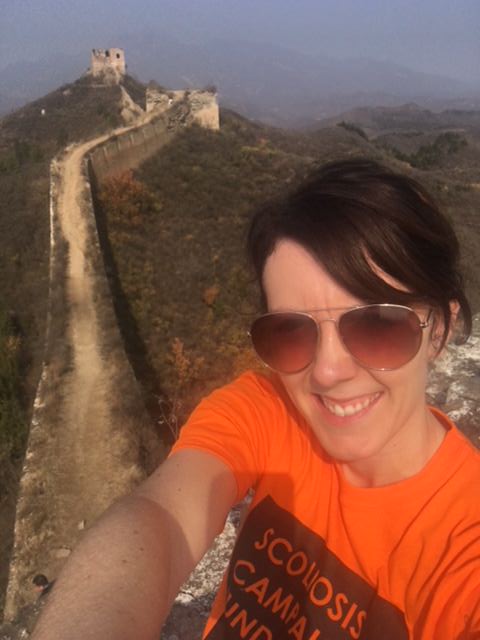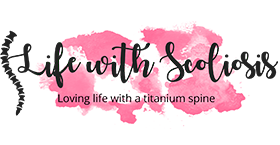
Getting Fit with Scoliosis: My 5 Best Scoliosis Exercises

Getting Fit with Scoliosis: 5 Best Exercises for Scoliosis
This post contains affiliate links
I thought I’d share my favourite scoliosis exercises and fitness challenges that have helped me since my scoliosis surgery. If you have scoliosis and fancy a new challenge, or want to get fitter, why not give some of the below a try..
1. 10K steps a day challenge

I personally think the 10K steps a day challenge is a fantastic challenge for those of us with scoliosis. Walking is a great scoliosis exercise, as it is low impact but incredibly effective at strengthening muscles in the legs and back. Walking also counts towards your recommended 150 minutes of weekly exercise.
If you are new to walking or find it difficult, it’s best to start gradually. Use an app on your phone to find out your average daily steps and increase the amount gradually. I use my Fitbit and I find this really encourages me to move more. It’s surprising how achievable 10K steps a day really is, even if you work in an office like me. If you’re interested, I wrote a post on how much I love my Fitbit and how much it’s helped me.
If you can commit to walking 10K steps a day, you will feel great. It will help to strengthen your back muscles, which will help with back pain over time. I now try and get 10K steps most days and it’s become part of my daily life.
2. 30 day Plank Challenge
I believe the plank is one of the best scoliosis exercises. Having a strong core is essential to keeping the lower back strong, reducing pain over time and preventing injury. The other great thing about the plank is it’s an alternative exercise to sit-ups if you find these difficult. It still works the core muscles, without putting too much pressure on the back/hips.
Equipment needed:
The good news is, you don’t need any equipment! You can pretty much do it anywhere and as it only takes seconds, it’s easy to fit around your day. There are many free apps you can download for a 30 day plank challenge, where you increase the time you hold the plank for each day. The only thing you may find useful is a decent exercise mat as it makes it more comfortable on your elbows. You can also use a Pilates/Fitness ball to rest your elbows on if getting down to the floor is too difficult. This is a variation I did when I was recovering from my scoliosis surgery.
If you’re wondering how to do the plank, check out this link or the photo of me doing the plank above.
There are many variations of the plank. If you are new to it, you can start by performing the plank on your knees or by using a Pilates ball as shown in the video below.
Scoliosis Exercises – Plank
3. Pilates
Pilates is a fantastic exercise for scoliosis, as it builds core strength. This is vital for supporting the spine and managing pain. I have attended Pilates classes in the past and it’s something I plan to do more of as I want to focus on increasing my core strength.
For those of us with scoliosis, it’s important to find an instructor with experience in teaching those with back conditions. It’s also important to make sure that the positions are done correctly to reduce the chance of injury.
Pilates books and DVDs for scoliosis
There are thousands of Pilates DVD’s available and it can be difficult to know which one to choose when you have scoliosis.
I was recommended and have purchased the below Pilates DVD by my NHS physiotherapist. It is specifically aimed at people with low back pain. I’ll be giving it a go and reviewing it soon, so look out for that. 🙂
I have also recently bought this book “Curves, Twists and Bends: A Practical Guide to Pilates for Scoliosis.” It has great reviews and tailored Pilates exercises for scoliosis.
Pilates ball scoliosis exercises
There are many useful scoliosis exercises that can be done using a Pilates ball (also called a fitness ball, stability ball or gym ball). I’ve listed my favourite Pilates ball scoliosis exercises and some useful resources below. These are all exercises I have been given in the past by a physiotherapist/personal trainer.
Pilates ball Wall Squats – how to do it:
- Place a Pilates/Fitness ball between your lower back and the wall
- Stand with your feet shoulder width apart and bend your knees very slightly, placing your hands on your thighs or hips
- Slowly squat down, bending your knees until the legs form 90-degree angles at the knees.
- Hold for a few seconds then slowly stand back up
- Repeat for 10-15 reps and do 3 sets (depending on fitness level)
Scoliosis Exercises: Wall Squats
Pilates ball Roll Out – how to do it:
- Kneel in front of the ball and place your hands on the top
- Roll the ball out in front of you as far as you can – keep your core pulled in and your back and arms straight
- Roll the ball back to start
- Repeat for 10-15 reps and do 3 sets (depending on fitness level)
Below is a good video which shows a few basic exercises on the ball for the core and back. These exercises are very similar to the ones I was given shortly following my scoliosis surgery. Just sitting on the ball and making small movements as shown in the video below really helps to improve core strength, balance and control, which is important following scoliosis surgery.
Scoliosis exercises – Core strengthening
Equipment needed:
I think it’s definitely worth investing in a stability/Pilates ball. There are so many stability ball exercises out there that can benefit scoliosis. These type of exercises help to increase core strength, whilst minimising strain on the back/spine. As with all exercises though, it’s important that they are done properly. If you are new to using a stability ball, it might be worth having someone to help you to start with as it can be tricky keeping your balance (I’m speaking from experience here)! It’s also important you get the right size ball for your height. A good guide is that when you are sat on it, your thighs should be at a 90 degree angle to the floor.
4. Cycling
Cycling is a great exercise for scoliosis as it is low impact, but it is also a fantastic cardio workout and strengthens the core muscles! You can either use an outdoor bike or an indoor exercise bike at home or at a gym. I prefer using an indoor bike and I’ve recently started going to spin classes at my gym. Spin classes are extremely difficult for me, but a great challenge and I really feel like I’ve worked up a sweat afterwards! It also feels like there is a lot less pressure on my back than when I go for a run. Cycling really is an amazing work out and great for improving your overall fitness.
5. Light weights and stretches
It’s important to keep the back strong and I’m of the opinion that strength training and stretching should not be feared by those of us with scoliosis. It is actually necessary in reducing pain and reducing future risk of injury. I used to be scared of using any kind of weights but I have recently started going to Body Pump classes as I want to get stronger. It’s important to start with light weights though and to avoid any exercise that causes pain.
Examples of the type of strength training exercises I have recently started doing can be found here. Everyone’s scoliosis is different though and these exercises will not be suitable for everyone. It’s important to discuss any new exercise regime with your Dr, personal trainer or physiotherapist to make sure that it is tailored to your needs.
Equipment needed:
If you are not a member of a gym, then it may be worth investing in some free weights / dumbells and doing some light weights at home – they can be done while watching the TV! Remember to start light at first to avoid injury.
Stretching
Stretching is very good for those of us with scoliosis as it can improve flexibility and help to reduce pain. Resistance bands are great for that – there are many exercises and stretches available using resistance bands online or from your Dr/physiotherapist.
Examples of some useful scoliosis stretches can be found here.
Scoliosis Exercises – Summary
Exercises for scoliosis should always be about keeping moving and should focus on developing and improving core strength. A new year is always a good time to make changes for the better and I’m going to be focusing more on improving my core strength, as well as continuing with my body pump, 10K steps a day and spin classes.
Do you have scoliosis and have a favourite exercise or fitness challenge that helps/has helped you?
Please share in the comments below 🙂
Enjoyed this post? Please follow me on Instagram, Facebook and Pinterest! Be sure to also subscribe to my YouTube channel!
Follow my blog on Bloglovin’
Disclaimers:
This article is not intended to substitute for informed medical advice. You should not use this information to diagnose or treat a health problem or condition. Always check with your doctor before changing or starting a new fitness routine.
The exercises listed in this article are intended to be helpful for those who have either not had scoliosis surgery or who have fully recovered, they are exercises that I find useful and will not be suitable for everyone with scoliosis. I accept no responsibility or liability for any injuries caused directly or indirectly through the performing of the exercises described. If you feel any discomfort or pain during any exercise, stop immediately.
If you have recently had scoliosis surgery, speak to your Dr/physiotherapist in order to get tailored exercises for you while you recover. You will need to be very careful and it will probably be difficult to do anything other than walking and simple exercises for a while (remember NO bending, lifting or twisting for at least 6 months following scoliosis surgery).

I had scoliosis surgery in 2010 and blog about my experiences living with scoliosis. My aim is to raise awareness of scoliosis and help and inspire others with the condition.





